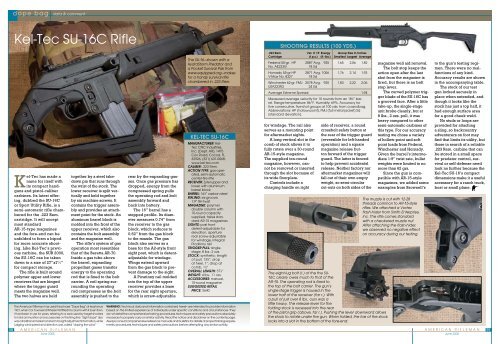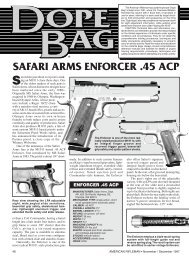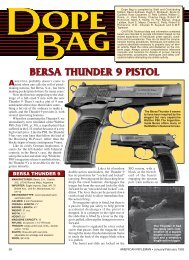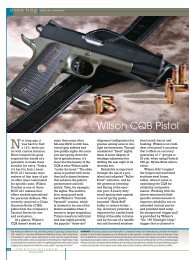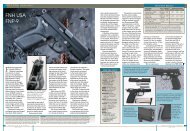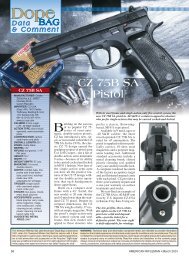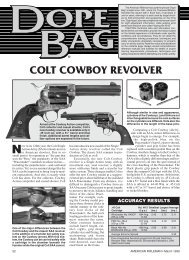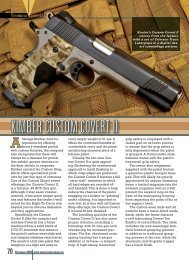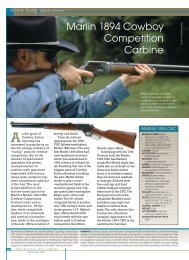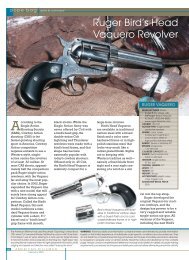Kel-Tec SU-16C Rifle
Kel-Tec SU-16C Rifle - The National Firearms Museum
Kel-Tec SU-16C Rifle - The National Firearms Museum
- No tags were found...
You also want an ePaper? Increase the reach of your titles
YUMPU automatically turns print PDFs into web optimized ePapers that Google loves.
dope bag data & comment<br />
<strong>Kel</strong>-<strong>Tec</strong> <strong>SU</strong>-<strong>16C</strong> <strong>Rifle</strong><br />
<strong>Kel</strong>-<strong>Tec</strong> has made a<br />
name for itself with<br />
its compact handguns<br />
and pistol-caliber<br />
carbines. Its latest offering,<br />
dubbed the <strong>SU</strong>-<strong>16C</strong><br />
or Sport Utility <strong>Rifle</strong>, is a<br />
semi-automatic rifle chambered<br />
for the .223 Rem.<br />
cartridge. It will accept<br />
most standard<br />
AR-15-type magazines<br />
and the fore-end can be<br />
unfolded to form a bipod<br />
for more accurate shooting.<br />
Like <strong>Kel</strong>-<strong>Tec</strong>’s previous<br />
carbine, the <strong>SU</strong>B 2000,<br />
the <strong>SU</strong>-<strong>16C</strong> can be taken<br />
down to a size of 27”x7 1 ⁄2”<br />
for compact storage.<br />
The rifle is built around<br />
polymer upper and lower<br />
receivers that are hinged<br />
where the trigger guard<br />
meets the magazine well.<br />
The two halves are held<br />
together by a steel takedown<br />
pin that runs through<br />
the wrist of the stock. The<br />
lower receiver is split vertically<br />
and held together<br />
by six machine screws. It<br />
contains the trigger assembly<br />
and provides an attachment<br />
point for the stock. An<br />
aluminum barrel block is<br />
molded into the front of the<br />
upper receiver, which also<br />
contains the bolt assembly<br />
and the magazine well.<br />
The rifle’s system of gas<br />
operation most resembles<br />
that of the Beretta AR-70.<br />
Inside a gas tube above<br />
the barrel, expanding<br />
propellant gases transfer<br />
energy to the operating<br />
rod that is fixed to the bolt<br />
carrier. A coil spring surrounding<br />
the operating<br />
rod compresses as the bolt<br />
assembly is pushed to the<br />
The American <strong>Rifle</strong>man has used the phrase “Dope Bag” at least since<br />
1921, when Col. Townsend Whelen first titled his column with it. Even then,<br />
it had been in use for years, referring to a sack used by target shooters<br />
to hold ammunition and accessories on the firing line. “Sight dope” also<br />
was a traditional marksman’s term for sight adjustment information, while<br />
judging wind speed and direction was called “doping the wind.”<br />
A M E R I C A N R I F L E M A N<br />
June 2005<br />
rear by the expanding gasses.<br />
Once gas pressure has<br />
dropped, energy from the<br />
compressed spring pulls<br />
the operating rod and bolt<br />
assembly forward and<br />
back into battery.<br />
The 16” barrel has a<br />
stepped profile. Its diameter<br />
measures 0.74” from<br />
the receiver to the gas<br />
block, which reduces to<br />
0.62” from the gas block<br />
to the muzzle. The gas<br />
block also serves as a<br />
base for the A2-style front<br />
sight post, which is detentadjustable<br />
for windage.<br />
Wings extend upward<br />
from the gas block to prevent<br />
damage to the sight.<br />
A Picatinny rail molded<br />
into the top of the upper<br />
receiver provides a base<br />
for the rear sight aperture,<br />
which is screw-adjustable<br />
The <strong>SU</strong>-16—shown with a<br />
HydraStorm Predator and<br />
a Pocket Survival Pak from<br />
www.equipped.org—makes<br />
for a handy survival rifle<br />
chambered in .223 Rem.<br />
KEL-TEC <strong>SU</strong>-<strong>16C</strong><br />
MANUFACTURER: <strong>Kel</strong>-<br />
<strong>Tec</strong> CNC Industries,<br />
Inc. (Dept. AR), 1475<br />
Cox Road, Cocoa, FL<br />
32926, (321) 631-0068;<br />
www.kel-tec.com<br />
CALIBER: .223 Rem.<br />
ACTION TYPE: gas-operated,<br />
semi-automatic<br />
center-fire rifle<br />
RECEIVER: Zytel upper and<br />
lower with aluminum<br />
barrel block<br />
BARREL: 16 1 ⁄2” carbon steel<br />
RIFLING: six-groove,<br />
1:9” RH twist<br />
MAGAZINE: polymer<br />
double column with<br />
10-round capacity<br />
supplied, takes standard<br />
AR-15 magazines<br />
SIGHTS: post front<br />
detent-adjustable for<br />
elevation, aperture<br />
rear screw-adjustable<br />
for windage, integral<br />
Picatinny rail<br />
TRIGGER PULL: singlestage;<br />
8 lbs., 2 ozs.<br />
STOCK: synthetic: length<br />
of pull, 13 3 ⁄8”; drop<br />
at heel, 1”; drop at<br />
comb, 1 1 ⁄4”<br />
OVERALL LENGTH: 37 1 ⁄2”<br />
WEIGHT: 4 lbs., 11 ozs.<br />
ACCESSORIES: manual,<br />
10-round magazine<br />
<strong>SU</strong>GGESTED RETAIL<br />
PRICE: $640<br />
WARNING: <strong>Tec</strong>hnical data and information contained herein are intended to provide information<br />
based on the limited experience of individuals under specific conditions and circumstances. They<br />
do not detail the comprehensive training procedures, techniques and safety precautions absolutely<br />
necessary to properly carry on similar activity. Read the notice and disclaimer on the contents page.<br />
Always consult comprehensive reference manuals and bulletins for details of proper training requirements,<br />
procedures, techniques and safety precautions before attempting any similar activity.<br />
SHOOTING RE<strong>SU</strong>LTS (100 YDS.)<br />
.223 Rem. Vel. @ 15’ Energy Group Size In Inches<br />
Cartridge (f.p.s.) (ft.-lbs.) Smallest Largest Average<br />
Federal 50-gr. HP 2887 Avg. 925 1.65 2.06 1.82<br />
No. AE223G<br />
18 Sd<br />
Hornady 55-gr HP 2871 Avg. 1006 1.76 2.14 1.93<br />
V-Max No. 8327 18 Sd<br />
Winchester 62-gr. FMJ 2578 Avg. 920 1.83 2.22 2.06<br />
USA223R3<br />
24 Sd<br />
Average Extreme Spread: 1.94<br />
Measured average velocity for 10 rounds from an 18 1 ⁄2” barrel.<br />
Range temperature: 86°F. Humidity: 69%. Accuracy for<br />
five consecutive, five-shot groups at 100 yds. from a sandbag.<br />
Abbreviations: HP (hollow-point), FMJ (full metal jacket) Sd<br />
(standard deviation).<br />
for windage. The rail also<br />
serves as a mounting point<br />
for aftermarket sights.<br />
A long vertical slot in the<br />
comb of stock allows it to<br />
fully rotate over a 30-round<br />
AR-15-style magazine.<br />
The supplied ten-round<br />
magazine, however, cannot<br />
be removed or inserted<br />
through the slot because of<br />
its wide floorplate.<br />
Controls include a<br />
charging handle on right<br />
side of receiver, a round<br />
crossbolt safety button at<br />
the rear of the trigger guard<br />
(reversible for left-handed<br />
operation) and a square<br />
magazine release button<br />
forward of the trigger<br />
guard. The latter is fenced<br />
to help prevent accidental<br />
release. Neither factory nor<br />
aftermarket magazines will<br />
fall out of their own empty<br />
weight, so semi-circular<br />
cut-outs on both sides of the<br />
The eight-lug bolt (r.) of the the <strong>SU</strong>-<br />
<strong>16C</strong> clearly owes much to that of the<br />
AR-15. The operating rod is fixed to<br />
the top of the bolt carrier. The gun’s<br />
single-stage trigger is housed in the<br />
lower half of the receiver (far r.). With<br />
a pull of just over 8 lbs., ours was a<br />
little heavy. The release lever for the<br />
folding stock is recessed into the rear<br />
of the pistol grip (above, far r.). Pushing the lever downward allows<br />
the stock to rotate under the gun. When folded, the toe of the stock<br />
locks into a slot in the bottom of the fore-end.<br />
magazine well aid removal.<br />
The bolt stop keeps the<br />
action open after the last<br />
shot from the magazine is<br />
fired, but there is no bolt<br />
stop lever.<br />
The curved polymer trigger<br />
blade of the <strong>SU</strong>-<strong>16C</strong> has<br />
a grooved face. After a little<br />
take-up, the single-stage<br />
unit broke cleanly, but at<br />
8 lbs., 2 ozs. pull, it was<br />
heavy compared to other<br />
semi-automatic carbines of<br />
this type. For our accuracy<br />
testing we chose a variety<br />
of hollow-point and softpoint<br />
loads from Federal,<br />
Winchester and Hornady.<br />
Given the barrel’s intermediate<br />
1:9” twist rate, bullet<br />
weights were limited to no<br />
more than 62 grs.<br />
Since the gun is compatible<br />
with AR-15-style<br />
magazines, we added some<br />
examples from Brownell’s<br />
The muzzle is cut with 12-28<br />
threads common to AR-15-style<br />
rifles. We attached a Vortex<br />
flash-hider from Smith Enterprise,<br />
Inc. The rifle comes standard<br />
with a checkered muzzle nut.<br />
After attaching the flash-hider,<br />
we observed no negative effect<br />
on accuracy during our testing.<br />
to the gun’s testing regimen.<br />
There were no malfunctions<br />
of any kind.<br />
Accuracy results are shown<br />
in the accompanying table.<br />
The stock of our test<br />
gun locked securely in<br />
place when extended, and<br />
though it looks like the<br />
stock has just a top half, it<br />
had enough surface area<br />
for a good cheek weld.<br />
No studs or loops are<br />
provided for attaching<br />
a sling, so backcountry<br />
adventurers on foot may<br />
find that limits its utility, but<br />
those in search of a reliable<br />
.223 Rem. carbine that can<br />
be stored in a small space<br />
for predator control, survival<br />
or self-defense need<br />
look no further because the<br />
<strong>Kel</strong>-<strong>Tec</strong> <strong>SU</strong>-16’s compact<br />
dimensions make it a useful<br />
accessory for a ranch truck,<br />
boat or small plane.<br />
58 A M E R I C A N R I F L E M A N 59<br />
June 2005
dope bag data & comment<br />
SIGARMS P226 X-Five<br />
SHOOTING RE<strong>SU</strong>LTS (25 YDS.)<br />
.40 S&W Vel. @ 15’ Energy Group Size In Inches<br />
Cartridge (f.p.s.) (ft.-lbs.) Smallest Largest Average<br />
Black Hills 976 Avg. 381 1.23 1.61 1.35<br />
180-gr. HP<br />
12 Sd<br />
Federal No. P40HST1 1040 Avg. 432 1.09 1.39 1.22<br />
180-gr. HST HP<br />
13 Sd<br />
Win. No. RA40TA 1125 Avg. 464 1.44 1.87 1.62<br />
165-gr. SXT HP<br />
24 Sd<br />
Average Extreme Spread: 1.40<br />
Measured average velocity for 10 rounds from a 5” barrel.<br />
Range temperature: 52°F. Humidity: 56%. Accuracy for five<br />
consecutive, five-shot groups at 25 yds. from a sandbag rest.<br />
Abbreviations: HP (hollow-point), Sd (standard deviation),<br />
Win. (Winchester).<br />
SIGARMS X-FIVE<br />
The X-Five’s lockup (above) will be familiar to<br />
fans of SIG pistols. The generous magazine<br />
well (r.) permitted bobble-free magazine<br />
insertion, and the oversize magazine release<br />
gave the shooting-hand thumb easy access<br />
to the release button without having to rotate<br />
the firearm in the hand (as is often the case<br />
with the M1911). Pointability of the X-Five was<br />
also judged to be very good.<br />
nomics and “feel” are as<br />
important as accuracy.<br />
Two experienced practical<br />
shooters who put the X-Five<br />
through its paces gave high<br />
marks to the gun’s slightly<br />
undercut trigger guard,<br />
30 line-per-inch frontstrap<br />
checkering, beavertail grip<br />
contour, target sights and<br />
extended ambidextrous<br />
thumb safety, which could<br />
easily and comfortably be<br />
ridden by the strong-hand<br />
thumb.<br />
Though slightly longer<br />
and wider than a comparable<br />
full-size 1911, and about<br />
a quarter-pound heavier;<br />
the X-Five handled nimbly<br />
in multiple-target drills. Its<br />
double-column magazine<br />
made its grip almost 3/16”<br />
wider than a single-stack<br />
M1911, and its grip circumference<br />
roughly 1/2”<br />
greater; nonetheless, the<br />
X-Five’s trigger reach was<br />
actually slightly shorter than<br />
a typical M1911 pistol with<br />
a long trigger. The comfortable<br />
grip contours made<br />
the X-Five’s larger grip size<br />
less apparent.<br />
With an MSRP of $2,499,<br />
the X-Five carries a hefty<br />
price, but no more than a<br />
custom 1911. The X-Five is<br />
the first pistol we’ve seen<br />
the capable of dethroning<br />
the 1911 from its position of<br />
preeminence in practical<br />
The accuracy, ergonomics,<br />
MANUFACTURER: SIG<br />
reliability and “feel” of the X-Five<br />
Sauer, Sauerstrasse 2-6,<br />
make it a worthy competitor to the<br />
D-24340 Eckernforde,<br />
venerable M1911 design.<br />
Germany, +49 4351<br />
4710, www.sigsauer.de<br />
IMPORTER: SIGARMS, Inc.<br />
(Dept. AR), 18 Industrial<br />
Single-action<br />
Drive, Exeter, NH 03833,<br />
semiautomatic<br />
handguns ible extended magazine reset and hold back the<br />
www. sigarms.com<br />
Accuracy of the X-Five is exceling<br />
thumb safety, revers-<br />
the sear and allowing it to<br />
(603) 772-2302,<br />
are de rigeur among release, front slide serrations,<br />
and beavertail frame teristic SIGARMS features .40 S&W (tested)<br />
with Federal’s 180-gr. HST hollow-<br />
hammer. Other charac-<br />
CALIBER: 9 mm Luger,<br />
lent, as shown by the 1.4” group<br />
practical shooting aficionados<br />
primarily because extension. At present, two are the spring steel claw<br />
ACTION TYPE: short-recoiloperated,<br />
center-fire<br />
point at left, and the 1.2” test target<br />
supplied with the pistol. The<br />
they allow the skilled calibers are offered: 9 mm extractor on the right side semi-automatic pistol<br />
shooter to deliver an Luger and .40 S&W.<br />
of the slide, stamped-steel FRAME: stainless steel<br />
short reach of X-Five’s smooth<br />
accurate first shot faster Internally, the pistol ejector and inertia firing BARREL: 5” stainless steel<br />
3 1 ⁄2-lb. trigger made it easy to get<br />
than other pistol types. offers few surprises for pin, whose passive safety is RIFLING: six grooves,<br />
the most out of the gun’s inherent<br />
mechanical accuracy.<br />
1:15” RH twist<br />
Accordingly, the M1911- those familiar with SIG disengaged only when the MAGAZINE: steel box with<br />
style pistol dominates Sauer guns. The barrel trigger is pulled.<br />
extended basepad,<br />
every practical pistol sport retains a square shoulder Mechanically, the most 14-round capacity<br />
windage and elevation. round test-fire session, ing shows that X-Fives<br />
in which it is used. In late which locks against the distinctive feature of the SIGHTS: undercut dovetailmounted<br />
front post,<br />
Our .40 S&W X-Five test although ejection was a typically group into 2” or<br />
2004, however, SIGARMS ejection port, as well as gun is its single-action<br />
rear blade click-adjustable<br />
for windage and<br />
round steel magazines with est loads. A situation eas-<br />
of accuracy equaling or<br />
pistol came with two 14- little anemic with the light-<br />
better at 50 yds., a level<br />
brought the new singleaction<br />
semi-automatic angled cams engage locked carry. The trigger elevation<br />
extended aluminum baseily<br />
remedied through the surpassing most custom-<br />
a large underlug whose trigger for cocked-and-<br />
P226 X-Five to American matching surfaces on the mechanism is user-adjustable<br />
for trigger position,<br />
.40 S&W P226 magazines weaker aftermarket P226 controllable thanks to the<br />
TRIGGER PULL: singleaction,<br />
two-stage,<br />
pads. Standard 12-round installation of a slightly built M1911s. Recoil was<br />
shores as an alternative to blued steel locking insert.<br />
3 1 ⁄4 lbs.<br />
that venerable design. Sear release is actuated by and a gunsmith can adjust OVERALL LENGTH: 8 will also work in the X-Five. recoil spring. Accuracy gun’s weight, ergonomics,<br />
3 ⁄4”<br />
The X-Five features a stamped steel trigger bar the trigger pull for pull HEIGHT: 5 7 ⁄8”<br />
Loads from Black Hills, of the X-Five was excellent:<br />
all ammunition tested dual-spring buffered recoil<br />
and mechanics, like the<br />
all-steel construction, linked to the pivoting trigger.<br />
When the slide recoils, Precision sights include<br />
weight and overtravel. WIDTH: 1 5 ⁄8”<br />
Federal and Winchester<br />
a 5” barrel, adjustable<br />
WEIGHT: 46 ozs.<br />
were used in our accuracy<br />
and reliability testing. enough groups in the 1.1” trigger was also excellent,<br />
grouped less than 2”, with system. Our test gun’s<br />
ACCESSORIES: hard<br />
target-type sights, and a semi-circular recess in an undercut 0.14”-wide<br />
plastic case, owners<br />
a host of ergonomic and the right slide rail cams front post mounted in a<br />
manual, test target<br />
Results are shown in the to 1.4” range to back up breaking crisply at 3 1 ⁄4 lbs.<br />
functional modifications for down an upward-protruding<br />
tab on the trigger bar, a wide rear blade with a<br />
PRICE: $2,499<br />
No malfunctions were get supplied with the gun. In a pistol intended for<br />
transverse dovetail, and <strong>SU</strong>GGESTED RETAIL<br />
accompanying table. the 1.2” 25-meter test tar-<br />
with no discernible creep.<br />
competition, including an<br />
ambidextrous sear-block-<br />
disconnecting the bar from 0.016” notch adjustable for<br />
noted during the 140-<br />
SIGARMS’ factory test-<br />
practical shooting, ergo-<br />
pistol competition.<br />
60 A M E R I C A N R I F L E M A N<br />
A M E R I C A N R I F L E M A N 61<br />
June 2005<br />
June 2005
dope bag data & comment<br />
The Century Int’l and pistol grip. The trigger,<br />
hammer and discon-<br />
Arms, Inc., GP WASR-<br />
10 is a semi-automatic-only<br />
nector are investment cast<br />
rendition of the from 4140 steel for Century<br />
famous 7.62x39 mm AKM by Thompson Investment<br />
rifle configured with a fixed Castings, while the compensator<br />
laminated stock and a laminated<br />
and stainless steel<br />
fore-end.<br />
gas piston are manufactured<br />
Manufactured in<br />
by a local firm. The<br />
Rumania, the 7.62x39 mm synthetic pistol grip is manufactured<br />
GP WASR-10 is imported<br />
by Century.<br />
as a “single-stack” rifle<br />
With the sunsetting<br />
that accepts single-column<br />
of the so-called<br />
10-round magazines. After “assault-weapons ban”<br />
arriving in the U.S., the in September of 2004,<br />
rifles are disassembled, the semi-automatic rifles are<br />
magazine wells machined now allowed to have features<br />
out to accept double-stack<br />
such as threaded<br />
magazines, and the requisite<br />
muzzles, folding/collaps-<br />
number of U.S.-made ing stocks and bayonet<br />
parts are installed for lugs. Consequently, this<br />
BATFE compliance.<br />
particular GP WASR-10<br />
In the case of this particular<br />
features a threaded muzzle<br />
variant, the U.S.-made (with a removable, slant<br />
parts are as follows: trigger,<br />
brake) and a bayonet lug.<br />
hammer, disconnector, Currently the rifles are<br />
compensator, gas piston imported without these<br />
62 A M E R I C A N R I F L E M A N<br />
June 2005<br />
Century<br />
GP WASR-10<br />
The GP WASR-10 rifle is faithful semi-automatic-only rendition<br />
of the famous AKM rifle. Shown with the rifle is a<br />
drum magazine (r.), and the background is a reproduction<br />
of a Cold War-era Soviet training poster.<br />
features, requiring Century<br />
to thread the muzzles and<br />
weld on and machine new<br />
bayonet lugs. The rifle<br />
came with a batch of accessories,<br />
including a canvas<br />
double magazine pouch,<br />
two 30-round magazines,<br />
a cleaning kit designed<br />
to fit in the buttstock storage<br />
compartment, and<br />
an early-style Model 59<br />
bayonet.<br />
Fit and finish clearly<br />
reflected the philosophy<br />
behind the design—utilitarian<br />
and nothing more.<br />
The magazine well was<br />
evenly cut with no sharp<br />
edges, and magazines<br />
locked easily into place.<br />
The barrel exhibited<br />
exterior tool marks, and<br />
parts such as the front and<br />
rear sight bases and the<br />
gas port block had rough<br />
shaping marks.The U.S.-<br />
made trigger and hammer<br />
appeared to be well-made.<br />
The compensator, although<br />
well-shaped, had very evident<br />
machining marks, and<br />
the bayonet lug was a bit<br />
oversized. Attaching and<br />
detaching the bayonet several<br />
times seemed to wear<br />
it in, with it easily locking<br />
into place and releasing<br />
after that.<br />
As a side note, actual<br />
AKM rifles originally manufactured<br />
to accept doublestack<br />
magazines have<br />
“dimples” on both sides of<br />
the lower receiver above<br />
the magazine well. The GP<br />
WASR-10 rifles are manufactured<br />
as single-stacks<br />
and, therefore, are devoid<br />
of such dimples.<br />
The GP WASR-10 does a<br />
good job of mimicking the<br />
appearance of a true AKM<br />
rifle and all its requisite<br />
The GP WASR-10 does a pretty good job<br />
of mimicking a true AKM rifle and is an outstanding<br />
deal for the minimal retail price.<br />
updates from the original<br />
AK-47. Like the AKM rifle,<br />
it has a stamped receiver,<br />
ribbed top cover and a gas<br />
tube void of vent holes. The<br />
fixed stock was also reminiscent<br />
of an AKM as it was<br />
made from laminated wood,<br />
and the fore-end matched<br />
quite well. The lower foreend,<br />
however, lacked the<br />
raised “swells” of the AKM.<br />
Although the fit and finish<br />
of the rifle was a bit rough<br />
around the edges, it is<br />
important to remember that,<br />
as the saying goes, handsome<br />
is as handsome does.<br />
Handling revealed a<br />
compact and handy rifle.<br />
Controls were easy to<br />
manipulate, but there was<br />
a bit of “stickiness” to the<br />
operation of the safety<br />
For accuracy testing, we fitted<br />
the GP WASR-10 with<br />
K-Var Corp.’s KV-04 scope<br />
mount (r.) and a Leupold<br />
scope. Since the GP WASR-10<br />
was originally manufactured<br />
as a single-stack magazine<br />
rifle, it does not have the<br />
familiar “dimples” in the lower<br />
area of the receiver above<br />
the magazine well (below).<br />
With the sunsetting of the so-called<br />
“assault weapons ban,” semi-automatic<br />
rifles can now have features such as<br />
threaded muzzles and bayonet lugs (r.).<br />
lever when in the “on”<br />
position. Removing the<br />
safety lever and giving it a<br />
slight tug outward seemed<br />
to solve the problem. As<br />
stated earlier, magazines<br />
were easily inserted and<br />
removed and locked up<br />
solidly. The trigger pull<br />
was surprisingly good,<br />
breaking cleanly at 7 1 ⁄4 lbs.<br />
Firing the rifle produced<br />
almost monotonous<br />
reliability. The rifle simply<br />
would not malfunction. We<br />
did, however, notice an<br />
unpleasant tendency for the<br />
trigger to “slap” the shooter’s<br />
finger during firing.<br />
For accuracy testing, we<br />
fitted a K-Var KV-04 scope<br />
mount (www.k-var.com)<br />
on the side-mount scope<br />
rail. Unlike Soviet scopes<br />
SHOOTING RE<strong>SU</strong>LTS (100 YDS.)<br />
7.62x39 mm Vel. @ 15’ Energy Group Size In Inches<br />
Cartridge (f.p.s.) (ft.-lbs.) Smallest Largest Average<br />
Black Hills 2280 Avg. 1,420 1.74 5.02 3.15<br />
123-gr. SP<br />
11 Sd<br />
Winchester SuperX 2225 Avg. 1,352 3.32 4.90 3.85<br />
123-gr. PSP<br />
31 Sd<br />
Wolf Steel Case 2422 Avg. 1,590 1.90 4.14 3.07<br />
122-gr. HP<br />
11 Sd<br />
Average Extreme Spread: 3.36<br />
Measured average velocity for 10 rounds from a 16 1 ⁄4” barrel.<br />
Range temperature: 73° F. Humidity: 8%. Accuracy for five<br />
consecutive, five-shot groups at 100 yds. from a sandbag.<br />
Abbreviations: HP (hollow point), PSP (pointed soft point),<br />
SP (soft point).<br />
and mounts, the K-Var unit<br />
centers the scope over the<br />
bore line—a welcome feature<br />
for our southpaw testers.<br />
Accuracy was on par<br />
with what is common for<br />
these rifles, printing average<br />
groups in the 3” range.<br />
The GP WASR-10 was<br />
easy to shoot and handily<br />
sized, although several<br />
testers complained that<br />
the short length of pull<br />
was distracting. The slant<br />
brake seemed to be mostly<br />
an affectation, albeit a<br />
rather interesting one.<br />
The GP WASR-10 represents<br />
an exceptional deal<br />
to those in the market for a<br />
short- to mid-range semiautomatic<br />
rifle that is both<br />
extremely reliable and<br />
highly affordable.<br />
GP WASR-10<br />
MANUFACTURER: Cugir<br />
Arsenal, Romania<br />
IMPORTER: Century Int’l<br />
Arms (Dept. AR), 430 S.<br />
Congress Ave., Suite 1,<br />
Delray Beach, FL 33445;<br />
(800) 527-1252; www.<br />
centuryarms.com<br />
CALIBER: 7.62x39 mm<br />
ACTION TYPE: gasoperated,<br />
semi-automatic<br />
center-fire rifle<br />
RECEIVER: Parkerized,<br />
stamped steel<br />
BARREL: 16 1 ⁄4”, Parkerized<br />
RIFLING: four-groove,<br />
1:10” RH twist<br />
MAGAZINE: detachable<br />
box<br />
SIGHTS: fixed-notch rear,<br />
windage-adjustable<br />
post front<br />
TRIGGER PULL: two-stage,<br />
7 1 ⁄4 lbs.<br />
STOCK: length of pull,<br />
12 3 ⁄4”; drop at heel, 1 1 ⁄2”;<br />
drop at comb, 1 1 ⁄2”<br />
OVERALL LENGTH: 35 1 ⁄4”<br />
WEIGHT: 7 lbs.<br />
ACCESSORIES: two<br />
30-round magazines,<br />
magazine pouch,<br />
cleaning kit, bayonet<br />
<strong>SU</strong>GGESTED RETAIL<br />
PRICE: $450<br />
A M E R I C A N R I F L E M A N<br />
June 2005<br />
63
64<br />
dope bag data & comment<br />
Nightforce 5.5-22x56 mm NXS<br />
While many makers<br />
offer highmagnification<br />
scopes, only a handful of<br />
high-end models are preferred<br />
by “professionals,”<br />
such as top long-range<br />
competitors and military<br />
snipers. Nightforce scopes,<br />
from Lightforce USA, have<br />
earned an enviable reputation<br />
among such shooters.<br />
Each Nightforce scope<br />
is assembled in the<br />
company’s plant in Idaho,<br />
and receives an extensive<br />
multi-point inspection that<br />
includes tests for optical<br />
quality, mechanical accuracy,<br />
thermal stability,<br />
water resistance and shock<br />
resistance to 1,250 Gs.<br />
The current Nightforce<br />
line consists of the NXS<br />
(Nightforce Extreme Scope)<br />
series, built with the tactical<br />
or military user in mind and<br />
including models from 3.5-<br />
15x50 mm to 12-42x56 mm;<br />
two NXS hunting models,<br />
the 1-4x24 mm and 2.5-<br />
10x24 mm; and the 8-32x56<br />
mm and 12-42x56 mm<br />
Precision Benchrest Series<br />
target scopes.<br />
The 30 mm 6061-T6 aluminum<br />
body tubes have<br />
walls two to three times<br />
thicker than those used in<br />
many comparable scopes.<br />
Mechanical durability and<br />
repeatability are assured<br />
by the use of carefully<br />
selected, hardened metals<br />
for internal components,<br />
extra-stiff, fatigue-proof<br />
titanium erector springs,<br />
and extremely tight<br />
machining and assembly<br />
tolerances.<br />
All air-to-glass surfaces<br />
receive a proprietary<br />
abrasion-resistant broadband<br />
coating that maximizes<br />
light transmission.<br />
Lenses are mounted using<br />
not only O-rings and metal<br />
lock rings, but also a proprietary<br />
bonding agent<br />
that provides a shock-<br />
A M E R I C A N R I F L E M A N<br />
June 2005<br />
Markings on turrets,<br />
including direction<br />
indicators, are easily<br />
seen from behind<br />
the scope.<br />
absorbing, strain-free and<br />
zero-movement lens bed.<br />
The 5.5-22x56 mm NXS<br />
has 4” of eye relief, 0.25”<br />
click values and 100 m.o.a.<br />
of elevation adjustment.<br />
Nine reticles are available<br />
for this scope, including<br />
various crosshair, Mil-Dot<br />
and ranging designs; our<br />
scope had the CH-2 fine<br />
crosshair. Reticles are in<br />
the second focal plane, so<br />
they appear the same size<br />
as magnification varies.<br />
We tested the 5.5-<br />
22x56 mm NXS on two<br />
highly accurate custom<br />
F-Class rifles, one based<br />
on an accurized Remington<br />
action in .308 Win. with<br />
a Shilen barrel and H-S<br />
Precision stock; and the<br />
other consisting of an H-<br />
S Precision action with a<br />
Douglas barrel in 6.5-.284<br />
Win. set in a Sinclair<br />
Nightforce scopes, long<br />
popular with military units<br />
and benchresters, have<br />
also become dominant on<br />
F-Class competition rifles.<br />
F-Class stock. Testing was<br />
performed at 100, 200 and<br />
300 yds., as well as during<br />
an actual F-Class match at<br />
600 and 1,000 yds.<br />
To put it simply, the<br />
scope performed superbly<br />
in every respect.<br />
Optical clarity, brightness<br />
and resolution rivaled that<br />
of a 45X spotting scope<br />
being used during the test<br />
session, and the windage<br />
and elevation adjustments<br />
were accurate and repeatable,<br />
with easily discernible<br />
clicks and highly<br />
visible index marks. No<br />
reticle shift was observed<br />
with either of the rifles<br />
used, and the scope’s<br />
parallax adjustment—conveniently<br />
located on the<br />
saddle—was effective at<br />
all ranges tested.<br />
With a list price of<br />
$1,400, the Nightforce 5.5-<br />
NXS2256<br />
MANUFACTURER:<br />
Lightforce USA, Inc.<br />
(Dept. AR), 1040 Hazen<br />
Lane, Orofino, ID 83544,<br />
(208) 476-9814, www.<br />
nightforceoptics.com<br />
MODEL: NXS2256<br />
MAGNIFICATION AND<br />
OBJECTIVE: 5.5-22X<br />
56 mm<br />
FINISH: black matte<br />
anodizing<br />
FIELD OF VIEW (FT. @ 100<br />
YDS.): 17.5 (5.5X),<br />
4.7 (22X)<br />
EYE RELIEF: 3.9”<br />
CLICK VALUE (IN. @ 100<br />
YDS/M.O.A.): 0.25”/0.25<br />
m.o.a.<br />
WINDAGE AND<br />
ELEVATION ADJUST-<br />
MENT RANGE: 100 m.o.a.<br />
(E), 60 m.o.a. (W)<br />
RETICLES: nine designs,<br />
including target<br />
crosshair, Mil-Dot and<br />
rangefinding reticles<br />
(CH-2 fine crosshair<br />
tested)<br />
LENGTH: 15.2”<br />
WEIGHT: 32 ozs.<br />
ACCESSORIES: lens caps,<br />
mirage tube, sunshade,<br />
milradian turrets, Zero<br />
Stop<br />
PRICE: $1,400<br />
22x56 mm is probably not<br />
suitable for—nor is intended<br />
for—the casual varmint<br />
or target shooter. For<br />
serious long-range riflery,<br />
however, where a national<br />
championship or critical<br />
military objective may be<br />
at stake, this scope would<br />
be hard to beat.


